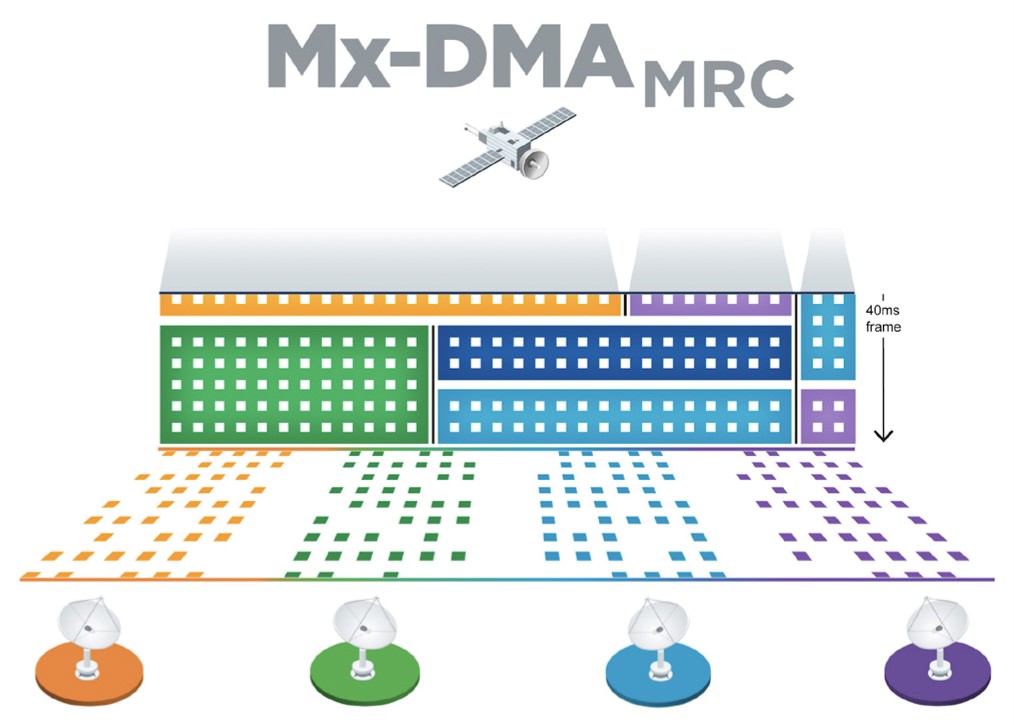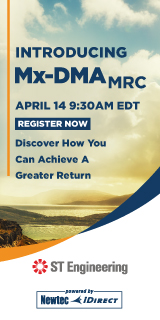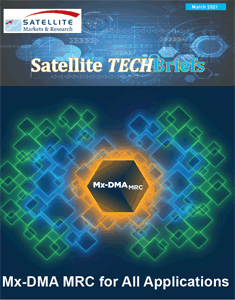No Compromises: Mx-DMA Multi-Resolution Coding (MRC) for All Applications
Los Angeles, Calif., March 24, 2021--Scalability: a few terminals to many thousands of terminals; flexibility: a few bits per second (bps) to hundreds of megabits (Mbps) AND dynamic, rapid response times. This is what to expect from recent innovations in Mx-DMA return technology from ST Engineering iDirect. No more trade-offs, you can have efficiency and scalability. Introducing Mx-DMA Multi- Resolution Coding (MRC)--simply the most powerful, efficient, dynamic, flexible and cost-effective return technology available today.
No More Trade-offs
As would be expected from ST Engineering iDirect, continuous innovation is the modus operandi; so, having invented a revolutionary return technology, Mx-DMA High Resolution Coding (HRC) in 2014, that gave users and service providers alike, more flexibility, greater efficiency, and significant cost savings, the company wasn’t content to rest on its laurels. Instead, it spent four years developing the upgraded and improved version: Mx-DMA MRC. Research and Development (R&D) is in ST Engineering iDirect’s DNA. Mx-DMA MRC marks the end of trade-offs between efficiency, scalability and agility.

Mx-DMA MRC unites Mx-DMA HRC efficiency with MF-TDMA scalability into a single return technology. Building on Mx-DMA HRC technology Mx-DMA now offers unprecedented service agility, extending the use of Mx-DMA to very large networks with thousands of terminals, and expanding the applicability and use of the technology to support a full spectrum of service types. Depending on the model, a Newtec Dialog® hub can handle over ten networks. Mx-DMA MRC supports larger-scale deployment of terminals, 25 times faster bandwidth allocation, and adaptive payload lengths to achieve important efficiency gains across all application traffic profiles.
First revealed at Satellite 2020, and launched early in 2021 Mx-DMA MRC is available as a software upgrade for all Dialog hubs and modems now.
Versatile yet Simple
Mx-DMA MRC adjusts the frequency plan, symbol rate modulation, transmission length, code block size and power in real-time for every terminal in the network, based on return traffic demand, QoS settings and link conditions. But, designing an Mx-DMA MRC link does not require precise knowledge of the traffic and terminal mix, as the link self-optimizes in real-time, providing a far simpler way to manage complex traffic demands. This also eliminates the need for the cumbersome trade-offs needed when predefining return carrier plans for a mix of terminal and service types as required.
As a result, Mx-DMA MRC is able to support the delivery of a mix of different traffic profiles using a shared return capacity. If a terminal has a steady traffic demand, it will be assigned continuous capacity and will operate in an SCPC like link with slowly changing transmission parameters, depending on link conditions. It will however, share capacity with highly overbooked terminals carrying bursty traffic. For the network operator, this means that activities such as uploading of high resolution images will happen at SCPC-like speeds, therefore increasing user satisfaction, but without a noticeable impact on capacity. The wide carrier is only there when needed. Not only does this give network operators and service providers the scale and agility to manage current customers more simply and efficiently, it also facilitates new business, by permitting them to offer new services across all markets, with the lowest total cost of ownership for a multi-service platform.
Mx-DMA MRC supports high speed returns of up to 100Mbps with initial symbol rates of 25Msps and modulations up to 64APSK with 34 MODCODs variations. MRC and HRC are not mutually exclusive, both can be supported on the same network, using the same hub infrastructure, so for applications needing return rates over 25 Msps per site HRC can be utilized. However, planned enhancements for MRC will support 100 Msps on the return; which is significantly faster than currently achievable with HRC.
Innovations over HRC
Scalable Demodulator Technology. Unlike HRC where each terminal is assigned its own carrier, with MRC, terminals not transmitting traffic, will seamlessly log-off and automatically restart transmission when needed. This means that there is no idle capacity consumption, enabling the technology to support a wide mix of traffic profiles in a shared return capacity. Mx-DMA MRC supports a minimum transmit length of 5ms, allowing up to 5,000 active terminals with a single multi-carrier demodulator; meaning that less hardware is needed at the hub, resulting in significant capex savings.
will seamlessly log-off and automatically restart transmission when needed. This means that there is no idle capacity consumption, enabling the technology to support a wide mix of traffic profiles in a shared return capacity. Mx-DMA MRC supports a minimum transmit length of 5ms, allowing up to 5,000 active terminals with a single multi-carrier demodulator; meaning that less hardware is needed at the hub, resulting in significant capex savings.
High Resolution Bandwidth Allocation. Mx-DMA MRC redistributes the available spectral resources 25 times per second, allowing it to seamlessly adapt to changing traffic demand and link conditions. Industry leading granularity in bandwidth assignment, lowest latency and jitter and highest efficiency for any traffic profile are made possible by a minimum transmission length of 5ms tied to a symbol rate of 100ksps and a 5% roll-off.
Adaptive Payload Length. Mx-DMA MRC adapts the payload length in real time, versus using the industry norm of pre-coded static payload length. By using adaptive code lengths, MRC optimizes efficiencies based on transmission length, resulting in reduced jitter. This also provides important efficiency gains for bursty traffic patterns, such as those associated with voice, Internet of Things (IoT) and Supervisory Control and Data Acquisition (SCADA)applications.
Automatic Regrowth Control. Ensures that the BUC always operates at its most efficient operations point, so reducing BUC cost and allowing GAN.
Applications
This is where Mx-DMA really shines. Due to its efficiency, flexibility and scalability, the patented technology behind Mx-DMA MRC ensures the highest traffic efficiency for any type of application. It can easily support a wide range of applications in the one network. From very bursty low data rate traffic, with a high degree of overbooking, such as is typically found in SCADA, PoS and consumer or SOHO broadband, all the way to the higher fixed bit rate applications needed for cellular backhaul and maritime applications. Between the two, are applications requiring higher bandwidth and less sharing than the very bursty applications at the bottom of the applications pyramid, Satellite News Gathering (SNG), Government, Enterprise and Small- and Medium-sized Enterpises (SME), for example. Mx-DMA MRC will seamlessly handle all of these.
 |
| To read or download a pdf of the full TECHBrief report on MX-DMA MRC sponsored by ST Engineering iDirect click here. |
“Service providers can now cover a myriad of use cases in a single return link, from cruise ships and large enterprise customers to SCADA and broadband access, sharing satellite capacity more efficiently over a group of satellite terminals and applications achieving the lowest Total Cost of Ownership (TCO),” said Bart Van Poucke, Vice-President of Product Management at ST Engineering iDirect.
“Consider a network with a mix of different services such as an enterprise connectivity deployment (a large network of low-rate, highly overbooked terminals) and a mobile backhaul deployment (a small network of high rate high availability terminals), in the same footprint. Both networks have very different service requirements, and very different link budgets. Before introduction of Mx-DMA MRC, given the requirements of both services, Mx-DMA HRC for mobile backhaul and MF-TDMA for enterprise were the designated return technologies and would operate in separate static return capacity. Mx-DMA MRC is suited to both types of services, allowing both services to share one chunk of return capacity, improving efficiency and statistical multiplexing,” Van Poucke added.
Merging the best of SCPC efficiency and MF-TDMA flexibility and scalability into a single waveform, minimizing operational complexity and maximizing statistical multiplexing, makes an investment in Mx-DMA MRC infrastructure simply the best way to future-proof your network.
Ground-breaking efficiency, scaled for thousands of terminals, total flexibility; the widest mix of applications and network types-- All in one package: Mx-DMA MRC.
--------------------------------------
 Elisabeth Tweedie has over 20 years experience at the cutting edge of new commmunications entertainment technologies. She is the founder and President of Definitive Direction (www.definitivedirection.com), a consultancy that focuses on researching and evaluating the long-term potential for new ventures, initiating their development, and identifying and developing appropriate alliances. During her 10 years at Hughes Electronics, she worked on every acquisition and new business that the company considered during her time there. She can be reached at etweedie@definitivedirection.com
Elisabeth Tweedie has over 20 years experience at the cutting edge of new commmunications entertainment technologies. She is the founder and President of Definitive Direction (www.definitivedirection.com), a consultancy that focuses on researching and evaluating the long-term potential for new ventures, initiating their development, and identifying and developing appropriate alliances. During her 10 years at Hughes Electronics, she worked on every acquisition and new business that the company considered during her time there. She can be reached at etweedie@definitivedirection.com






